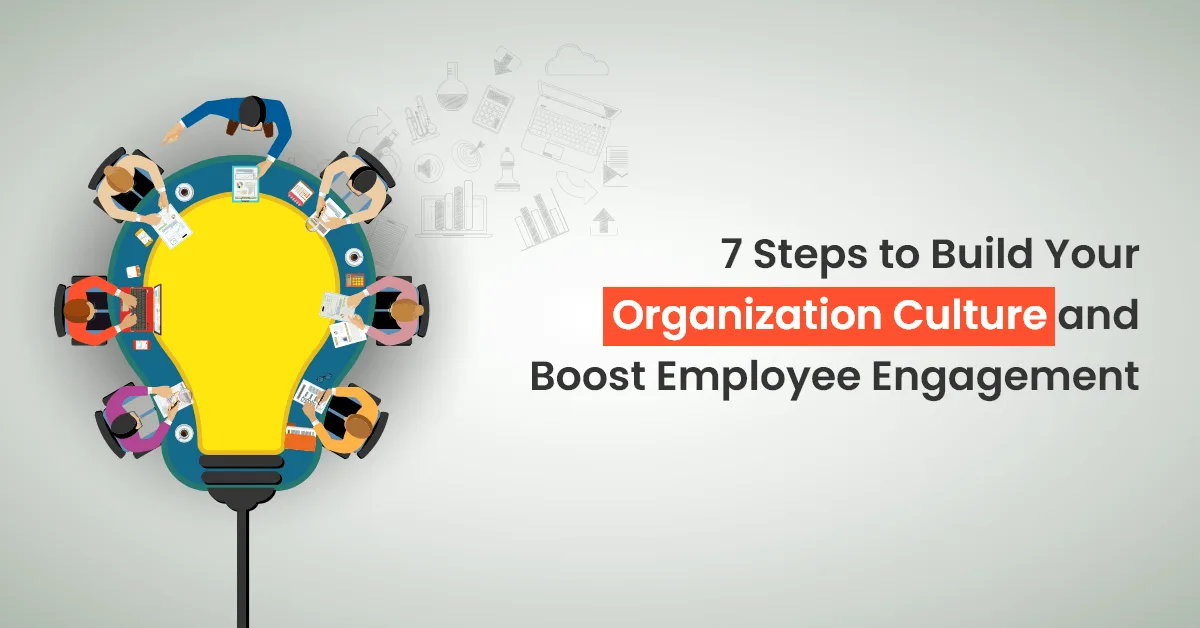7 Steps to Build Your Organization Culture and Boost Employee Engagement

If it is so hard to define the organizational culture, it is because each company, each manager and each employee has their own definition. Interview 400 employees of a company and you will get 400 different definitions. Even if it is expressed through behaviors, employee engagement, dress style, attitudes, and traditions, the company culture is lived and felt more than it is seen.
Shared values, a way of thinking and vision make a company blend in the diversity of talents as a united whole to build a successful workplace culture. But then where does it come from? Is it natural or forced? Innate or inspired? Can we build it, change it, or develop it? And what are the variables to activate it? What is certain is that a strong and clear organizational culture cannot be obtained without effort. It is the result of a will, a strategy and also a good dose of intuition.
A healthy and positive work culture can allow tens, hundreds or thousands of strangers to co-operate and work together for a common purpose.
How to Build the Right Organization Culture?
A great deal of ink and thought has been spent to understand the term organization culture. The term is used many times by Corporate Executives, many consultants (who make a living in assisting companies to improve their “work culture”). Conversationally, when we ask employees to define company culture the most common answer is “values of a group”.
Gone are the days, when employees used to be satisfied with job security and didn’t care about values and traditions. Today’s workforce needs much more than a 9-5 job and a comfortable place to work from. Organizational culture, now, is not just perks and compensation. It is more than that!!
Here are 7 Steps that can help you Build a Positive Work Environment and Develop the Organization Culture:
Find the Values that Define You
As with any strategy, work on the company culture begins with a phase of reflection and analysis – a reflection on the values, the vision of your company and other drivers of your own. These are the fundamentals at the base of your DNA, which you can find in your management style, your general atmosphere, and your mentality. And if you can’t identify them, it’s proof that you lack a good workplace culture!
Your Most Beautiful Weapon – The Office
And what could be better than redecorating your offices to express the values? Reflecting on the tastes, preferences, and personality of a company, interior architecture is the first vector of expression of your organization culture. The art and design give a soul to your office; meaning, emotion and sensations to your employees.
Teambuilding for a Healthy Work Culture

If your employees are nothing more than strangers to each other, you have a problem! The organization culture derives its strength from the collective. The more it is welded, the more it is shared and the more it becomes indestructible. The HR team can work to develop proximity, create links and gain social cohesion. The organization of external events will allow it to work on social relations between your employees. A business picnic, a day in an amusement park, a trip to laugh, have fun and talk about family life, passions and hobbies with loved ones and colleagues. Moments lived outside the offices that unite a collective around anecdotes, stories, and common memories. In addition to welding your teams, sporting events will be excellent for making your employees persevering, fierce competitors in the Olympic form to represent your colors and your company culture.
Shared Commitment

If leaders are precious elements, it is because they are often the most committed and the first to believe, defend and share ideas, positions, and corporate culture. Conversely, the lack of commitment or disengagement provokes permanent questioning, negative and destructive behavior. This is why you must research, inspire and ensure the commitment of all your employees, especially for those who are not spontaneous.
Personal Development

Having been out of school for several years and trained on the job, it has been a long time since your employees have learned new things or acquired new skills. An absence of training and personal development can slowly kill the commitment of your employees. Empowering employees to participate in conferences, seminars, training, or other professional events is the duty of the company. In addition to challenging them intellectually, teaching them new skills, they gain in ambition and motivation.
Transparency, Loyalty, and Trust
If each company has its own values, transparency, loyalty, and trust seem to us to be universal values essential for positive work culture. Because to work hand in hand and form a united group, you must first have confidence. Trust in your leaders, managers, colleagues or employees requires honesty and transparency. This will make your employees loyal collaborators. Indeed, it is always harder to betray, abandon or deceive a colleague who trusts us, who believes in us.
Bet on transparency – the one that not only passes through your communication but also through your offices. Open meeting rooms, offices and keep all your teams informed of the company’s activity, its successes as well as its failures. Not taking the time to inform your employees is the best way to exclude them by giving them the feeling of being left out, and of not being part of the ‘business’.
To communicate what is happening at all levels and in all departments to improve your existing company culture.
Innovation, a Great Ally
A fantastic lever for economic and social performance, a guarantee of competitiveness, innovation is must be cultivated at all times! Whether technological, marketing, commercial, social, product or just administrative – innovation must be developed in all its forms, at all levels and at all times.
More than its purpose, aim at imbibing in your employees the desire to go forward, to create and to surpass their potential and this will act as the strength of your company. Such a healthy workplace culture encourages the proactiveness and enthusiasm of the employees.
This is not an exhaustive list and there are many more things that you can do to build employee engagement and create a strong work culture. However, these are excellent points, to begin with,
We at OneClick have used all the above suggestions and observed a spike in productivity and employee retention. What is your take?
Organizational Culture @OneClick
In our efforts to make OneClick IT Consultancy, as one of the best software development organizations globally, we follow a thumb rule that is “caring about each employee’s career dreams”.
We provide freedom, flexibility; trust and encourage our employees to get innovative and creative. We have a friendly work environment that encourages the team members to work smart and hard for achieving their dreams which directly/indirectly facilitates the organization’s growth. Also, We encourage open discussion and value feedback and constructive criticism. And with all of this, we take pride in our work culture that is filled with positivity.


